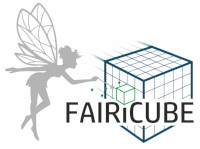In today’s data-driven world, geospatial analysis plays a crucial role in addressing urban and environmental challenges. In October students from Wageningen University & Research (WUR), enrolled in the Geoscripting course are invited to dive into cutting-edge geospatial problems linked to FAIRiCUBE. By applying advanced computational and geospatial techniques, students are invited to tackle three real-world challenges linked to FAIRiCUBE Use Cases: Understanding the urban heat island effect, Estimating building heights for urban planning for 3D city modeling and Mapping Invasive Species in European Cities.
Challenge related to Use case 1: Understanding the urban heat island effect
The urban heat island (UHI) phenomenon, where cities experience higher temperatures than their surrounding rural areas, is a growing concern for urban planners, particularly in the context of climate change. City administrations often lack the data needed to assess the effectiveness of mitigation measures, such as increasing green spaces or improving urban design. In this challenge, WUR students are working on assessing the effects of various environmental variables on urban air temperature, with a particular focus on the city of Vienna. Their goal is two-fold: first, to identify which environmental factors—such as the degree of urban sealing, vegetation cover, and proximity to water—most strongly influence temperature readings around weather stations; and second, to use remote sensing data to model and predict air temperatures across the entire city. The students are provided with a wealth of geospatial data, including land surface temperature (LST) from Landsat-8, digital elevation models (DEMs), land use maps, and weather station readings. They are tasked with building statistical models that can accurately predict air temperature based on LST and the identified environmental factors. This work will provide valuable insights for city planners looking to mitigate the impacts of UHI and improve urban resilience.
Challenge related to Use case 4: Estimating building heights for urban planning
In urban planning, having precise data on the height of buildings is essential for numerous applications, from solar panel placement and shading analysis to wind flow modeling and noise propagation studies. Unfortunately, in many cases, detailed height data is not available, particularly in open-source datasets like OpenStreetMap (OSM), where less than 3% of buildings include height information. To address this gap, WUR students are challenged to leverage Digital Elevation Models (DEMs) and building footprint data from OSM to estimate the height of buildings in Wageningen, Netherlands. Their approach involves creating a Canopy Height Model (CHM), which represents the height of buildings and other objects by subtracting a Digital Terrain Model (DTM) (ground elevation) from a Digital Surface Model (DSM) (surface features like buildings and trees). Students will develop Python scripts to process these datasets, extract building heights, and compare their estimates with the limited height information available in OSM. This exercise not only helps students sharpen their geospatial processing and scripting skills but also provides urban planners with critical 3D data for sustainable city development. Such 3D models can support a wide range of urban applications, from infrastructure development to enhancing the quality of life for residents.
Challenge related to Use case 5: Mapping Invasive Species in European Cities
Biological invasions are a major threat to biodiversity, and urban ecosystems are particularly vulnerable to the spread of invasive species due to their unique environmental conditions. In this challenge, students are tasked with mapping the distribution of Reynoutria japonica (Japanese knotweed), a highly invasive plant species that disrupts urban and riverbank ecosystems. The project focuses on Vienna and Luxembourg, where students will use data from the Global Biological Information Facility (GBIF) and remote sensing platforms like Wekeo to map the presence of this invasive species. They will also explore how factors such as land use and temperature influence its spread. By creating heat maps of the species’ distribution, the students aim to highlight the areas most affected and compare the invasions between the two cities. This task not only helps students develop skills in handling complex ecological datasets but also contributes to a growing body of knowledge on how to manage biological invasions in urban areas. Their findings could inform policies aimed at controlling invasive species and protecting biodiversity in European cities.
Curious about the results of student work?
If WUR students will select one or more of these challenges, their work will be made available on our website, allowing both the public and fellow researchers to explore their findings and methodologies. By sharing the work done by students, FAIRiCUBE promotes transparency and collaboration to tackle Geospatial challenges with innovative, data-driven solutions.

